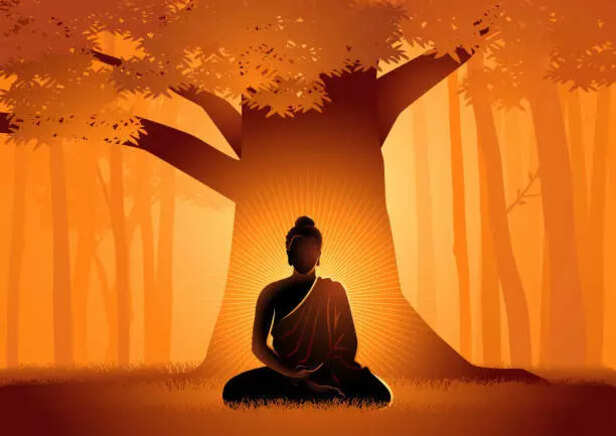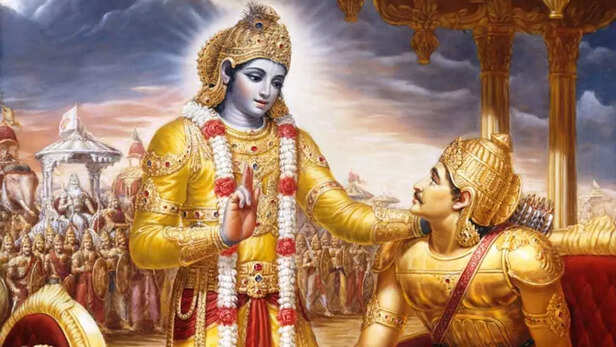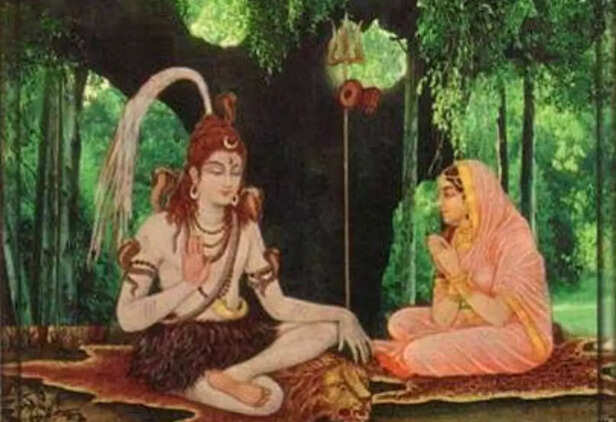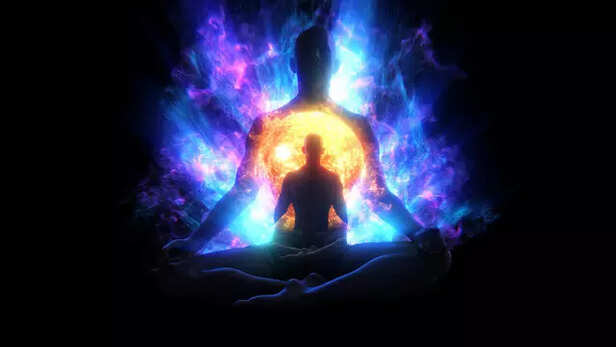The One Who Meditated on Life Forgot to Live; The One Who Lived Now Teaches Meditation—Art of Living
Ankit Gupta | May 19, 2025, 23:31 IST
In the silence of Himalayan caves and the bustle of modern cities, one eternal question remains: Is living about knowing, or is it about being? Is wisdom a matter of thought—or of experience? The Indian spiritual tradition, vast and varied, offers an answer that dissolves dualities. It asks not just that we sit still and meditate, but also that we rise and live—not in the mind, but in the fullness of being.
“Yāvajjīveta sukhaṃ jīveta Ṟraṇaṃ kṛtvā ghṛtam pibet.”
— Charvaka Philosophy
“Yogasthaḥ kuru karmāṇi saṃgaṁ tyaktvā dhanañjaya.”
— Bhagavad Gita 2.48
In the stillness of Himalayan caves and the bustle of modern life, a question echoes eternally: Is life meant to be understood or experienced? Indian spiritual traditions provide a path that transcends this binary. They urge us not only to meditate but to live — not merely in thought, but in the fullness of being.

The Upanishads declare, “Neti, Neti” (Not this, not this), a process of intellectual negation. But even this points us toward a deeper truth: that life itself, in its simplest form, is sacred. The Taittiriya Upanishad declares:
“Annam Brahma.” — Food is God.
To live consciously is to honor the ordinary. We may meditate for hours, chant mantras, and study the Vedas, yet remain disconnected from the holiness of touch, the intimacy of breath, the taste of food. Living becomes sacred when the act of being alive is revered in itself.
Indian philosophy recognizes this through the lens of Dharma, not merely as a duty but as the path of righteous engagement. To walk into life is to live our dharma with awareness.

One may memorize the Bhagavad Gita, quote Patanjali's Yoga Sutras, or recite Sanskrit flawlessly—yet still be deeply unsettled within. The scriptures do not glorify knowledge for its own sake; they glorify transformation.
The Mandukya Upanishad speaks of the state beyond waking, dreaming, and deep sleep: Turiya, the silence beyond sound:
“Amātraḥ caturthaḥ avyavahāryaḥ prapañcopaśamaḥ śivo advaitaḥ.”
— The Fourth is silence; it is the end of duality.
Many seekers hide in concepts, avoiding the raw silence where the ego dissolves. But it is in silence that the Gita was received. Arjuna was not intellectually ready; he was emotionally broken. And it is only in that surrender that knowledge descended, not as theory but as lived realization.
Krishna did not speak from a podium—he whispered into Arjuna’s battlefield.

“Prāṇo hi bhūtānām āyuḥ.” — Chandogya Upanishad
— Breath is the life of all beings.
In Indian tradition, prana (breath-energy) is the thread of life. The Hatha Yoga Pradipika says:
“When prana moves, chitta moves. When prana is still, chitta is still.”
You cannot think your way into life. You breathe into it. You fall. You weep. You kiss. You err. That is the great spiritual laboratory.
Rama walked the forest barefoot. Krishna danced and warred. Shiva meditated and performed the Tandava. All of them embraced the dirt of life, not just its concept.
Living is not in perfection. It is in embodiment. That is why the Bhagavata Purana praises the leelas of Krishna: they were playful, imperfect, and profound.
True wisdom in Indian lore rarely shouts. It whispers.
Gargi questioned Yajnavalkya not with arrogance but with fearless humility. Shabari offered tasted berries to Rama with childlike love. Bhishma whispered dharma from his deathbed, not from a throne.
These figures weren’t loud. They were true. They had bled, waited, risked, and still opened their hearts. Indian scriptures honor these souls more than the polished debaters.
Even the Mahabharata, in its final stretch, has Yudhishthira meet a dog at the gates of heaven—a test of compassion, not intellect. The Vedas do not ask, "What do you know?" They ask, "Who are you when stripped of knowing?"

Meditation is not escape. The Gita urges action:
“Karmaḥy evādhikāras te mā phaleḥu kadācana.”
— You have the right to action, not to its fruits.
Krishna tells Arjuna to meditate, yes—but to fight too. Renunciation is not withdrawal; it is engagement without obsession.
The Chandogya Upanishad ends in the famous dictum:
“Tat Tvam Asi.” — Thou art That.
But this realization comes after a life of study, service, contemplation, and deep living. Not withdrawal from the world, but surrender to its deeper current.
To sit still is sacred. But to rise and walk into the day with an open heart is no less holy.

“Sarvam khalvidam brahma.” — Chandogya Upanishad
— All this is Brahman.
This affirmation means that the Divine is not elsewhere. It is here — in your mistakes, your breath, your morning tea, your heartbreaks.
To chant mantras without kindness is hollow. To meditate without compassion is escape.
The scriptures are not ladders to climb but mirrors to hold up. They ask not for performance, but for presence. The Yoga Vasistha says:
“The world is as you see it.”
If you see it as mundane, it remains so. If you see it as sacred, everything—every flower, failure, and footprint—becomes holy.
“Tapasā brahmavidyā jñeyā.” — Through tapas (austerity), Brahman is known.
But what is tapas? Not just penance. It is living through the fire of life without closing the heart. It's forgiving when wronged, trusting when afraid, loving after loss.
Savitri fought death with love. Meera defied kings with devotion. Hanuman crossed oceans for seva. These are not abstract heroes; they are embodiments of walked wisdom.
So yes—sit down. Close your eyes. Meditate.
But also: Stand up. Open your heart. Risk. Bleed. Love. Walk barefoot into life.
Because the divine is not waiting only in the ashram. It is in the market, in the battlefield, in your child’s laughter, in your own trembling breath.
The one who meditated on life may forget to live. But the one who lived fully now teaches without speaking.
They danced barefoot under the storm.
“Loka-sangrahārthaḥ” — for the welfare of the world.
— Bhagavad Gita 3.20
Let your life be your mantra. Let your presence be your scripture. Let your walk be your worship.
That is Sanatana. That is living.
— Charvaka Philosophy
“Yogasthaḥ kuru karmāṇi saṃgaṁ tyaktvā dhanañjaya.”
— Bhagavad Gita 2.48
In the stillness of Himalayan caves and the bustle of modern life, a question echoes eternally: Is life meant to be understood or experienced? Indian spiritual traditions provide a path that transcends this binary. They urge us not only to meditate but to live — not merely in thought, but in the fullness of being.
Thinking Is Easy, Living Is Sacred

Raw Functionality
The Upanishads declare, “Neti, Neti” (Not this, not this), a process of intellectual negation. But even this points us toward a deeper truth: that life itself, in its simplest form, is sacred. The Taittiriya Upanishad declares:
“Annam Brahma.” — Food is God.
To live consciously is to honor the ordinary. We may meditate for hours, chant mantras, and study the Vedas, yet remain disconnected from the holiness of touch, the intimacy of breath, the taste of food. Living becomes sacred when the act of being alive is revered in itself.
Indian philosophy recognizes this through the lens of Dharma, not merely as a duty but as the path of righteous engagement. To walk into life is to live our dharma with awareness.
You Can Know All the Right Words and Still Run from Silence

Bhagavad Gita
One may memorize the Bhagavad Gita, quote Patanjali's Yoga Sutras, or recite Sanskrit flawlessly—yet still be deeply unsettled within. The scriptures do not glorify knowledge for its own sake; they glorify transformation.
The Mandukya Upanishad speaks of the state beyond waking, dreaming, and deep sleep: Turiya, the silence beyond sound:
“Amātraḥ caturthaḥ avyavahāryaḥ prapañcopaśamaḥ śivo advaitaḥ.”
— The Fourth is silence; it is the end of duality.
Many seekers hide in concepts, avoiding the raw silence where the ego dissolves. But it is in silence that the Gita was received. Arjuna was not intellectually ready; he was emotionally broken. And it is only in that surrender that knowledge descended, not as theory but as lived realization.
Krishna did not speak from a podium—he whispered into Arjuna’s battlefield.
Life Happens in the Breath, the Dirt, the Mistake

Inhale the Awareness
“Prāṇo hi bhūtānām āyuḥ.” — Chandogya Upanishad
— Breath is the life of all beings.
In Indian tradition, prana (breath-energy) is the thread of life. The Hatha Yoga Pradipika says:
“When prana moves, chitta moves. When prana is still, chitta is still.”
You cannot think your way into life. You breathe into it. You fall. You weep. You kiss. You err. That is the great spiritual laboratory.
Rama walked the forest barefoot. Krishna danced and warred. Shiva meditated and performed the Tandava. All of them embraced the dirt of life, not just its concept.
Living is not in perfection. It is in embodiment. That is why the Bhagavata Purana praises the leelas of Krishna: they were playful, imperfect, and profound.
The Quiet Ones Have Touched the Truth
Gargi questioned Yajnavalkya not with arrogance but with fearless humility. Shabari offered tasted berries to Rama with childlike love. Bhishma whispered dharma from his deathbed, not from a throne.
These figures weren’t loud. They were true. They had bled, waited, risked, and still opened their hearts. Indian scriptures honor these souls more than the polished debaters.
Even the Mahabharata, in its final stretch, has Yudhishthira meet a dog at the gates of heaven—a test of compassion, not intellect. The Vedas do not ask, "What do you know?" They ask, "Who are you when stripped of knowing?"
Sit, Meditate… But Also Walk Into Life

Duality in One
Meditation is not escape. The Gita urges action:
“Karmaḥy evādhikāras te mā phaleḥu kadācana.”
— You have the right to action, not to its fruits.
Krishna tells Arjuna to meditate, yes—but to fight too. Renunciation is not withdrawal; it is engagement without obsession.
The Chandogya Upanishad ends in the famous dictum:
“Tat Tvam Asi.” — Thou art That.
But this realization comes after a life of study, service, contemplation, and deep living. Not withdrawal from the world, but surrender to its deeper current.
To sit still is sacred. But to rise and walk into the day with an open heart is no less holy.
Sacredness Is in the Ordinary

Manifestating the true self
“Sarvam khalvidam brahma.” — Chandogya Upanishad
— All this is Brahman.
This affirmation means that the Divine is not elsewhere. It is here — in your mistakes, your breath, your morning tea, your heartbreaks.
To chant mantras without kindness is hollow. To meditate without compassion is escape.
The scriptures are not ladders to climb but mirrors to hold up. They ask not for performance, but for presence. The Yoga Vasistha says:
“The world is as you see it.”
If you see it as mundane, it remains so. If you see it as sacred, everything—every flower, failure, and footprint—becomes holy.
Bleeding, Risking, Dancing: The Real Sadhana
But what is tapas? Not just penance. It is living through the fire of life without closing the heart. It's forgiving when wronged, trusting when afraid, loving after loss.
Savitri fought death with love. Meera defied kings with devotion. Hanuman crossed oceans for seva. These are not abstract heroes; they are embodiments of walked wisdom.
The Dance of Life and the Stillness Within
But also: Stand up. Open your heart. Risk. Bleed. Love. Walk barefoot into life.
Because the divine is not waiting only in the ashram. It is in the market, in the battlefield, in your child’s laughter, in your own trembling breath.
The one who meditated on life may forget to live. But the one who lived fully now teaches without speaking.
They danced barefoot under the storm.
“Loka-sangrahārthaḥ” — for the welfare of the world.
— Bhagavad Gita 3.20
Let your life be your mantra. Let your presence be your scripture. Let your walk be your worship.
That is Sanatana. That is living.
